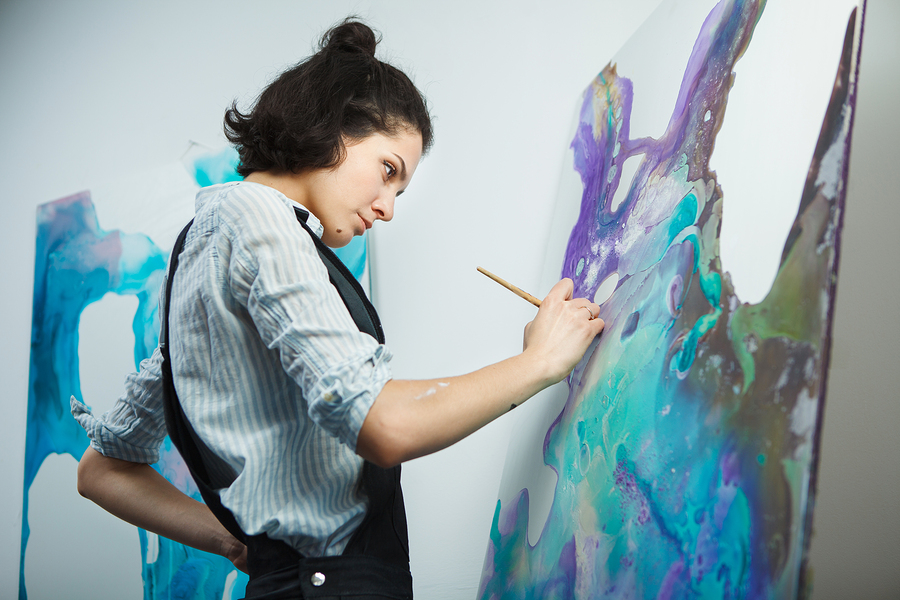 What can the sweep of a paint-filled brush across a blank canvas do for someone with mental illness? A lot.
What can the sweep of a paint-filled brush across a blank canvas do for someone with mental illness? A lot.
Mention art therapy in the same sentence as mental illness and clichéd images of small groups of catatonic people sitting at easels, guided by an instructor, come to mind. But, art therapy can offer so much more to those living with—and trying to overcome—mental illnesses. It can offer expression, freedom and the opportunity to explore the inner workings of their minds.
According to an article by Lea Winerman, published by the American Psychological Association, each of the creative art therapies in mental health treatment—dance, music, and theatre, as well as drawing and painting—had its beginnings more than half a century ago in the 1940s and ‘50s. Originally, the therapies were introduced “in the context of working with patients who could not express themselves verbally”.
Over the years, however, psychologists have come to rely on art, also known as expressive therapies, to help all clients find more ways to articulate their thoughts and emotions.
Winerman quotes Ilene Serlin, Ph.D., a psychologist who practices in San Francisco: “I see [art therapy] as part of a whole-person approach to therapy," Serlin said. "I think a collaborative approach to health care is essential, and creative arts therapy is part of that. We need to step outside our niches."
In a 2016 article she wrote for PsychCentral.com, Taylor Bourassa said, “The most positive aspect of art therapy is that it is a non-verbal approach to understanding the self.”
Examining the treatment’s encouraging results, Bourassa drew on the work of both philosopher Plato and psychoanalyst Sigmund Freud—and their beliefs in the healing power of art. “In art therapy, we do not just draw, or paint, rather we delve deeper and see inside ourselves—just as we would in psychotherapy. [Art therapy] is much more than a source of entertainment,” she explained. “It is rooted in the intersection between psychotherapeutic interventions and art as expression”.
Art therapy can be as simple as providing a patient with crayons, markers and paper during a therapy session, or as elaborate as establishing distinctly separate art production locations and using more elaborate art supplies away from therapy clinics and offices. It can take place individually or in groups.
Michael Friedman, Adjunct Associate Professor at Columbia University, recognizes that for individuals who have had to face the stigma associated with having a mental illness, art provides a chance for expression and exploration. But it also allows these artists an opportunity to escape the negative labels.
In 2012, Friedman visited the HAI (Healing Arts Initiative) Art Studio in the Soho district of New York City. The studio—where all of the artists have mental illnesses--is funded as a mental health initiative with the aim to “facilitate rehabilitation”.
Friedman spoke with many HAI artists, quoting one who explained that because “of the stigma about mental illness, I get treated like I am not functional in society. Here we are treated like artists.”
After his visit, Friedman wrote, “Being with so many like-minded people and having a sense of camaraderie are clearly important dimensions of the experience for these artists. But there’s much more to it.” He added, “It’s being in a place without stigma, where people believe in themselves and their abilities.”
With roots that harken back into the middle of the 20th century, art therapy is not now. Yet contemporary research into its delivery and efficacy is still being done. A recent study in Sweden involved a group of patients with depression ranging from severe to moderately severe. Members of the group were monitored as they participated in 10 sessions of art therapy. Their results were compared to a control group of patients with depression that did not receive art therapy sessions.
Writer Traci Pedersen, in her article, Art Therapy May Ease Severe Depression, explained that this “research was conducted by licensed occupational and art therapist Christina Blomdahl, Ph.D., as part of her dissertation at Sahlgrenska Academy at the University of Gothenburg in Sweden”.
Unlike the art produced in Soho’s HAI Studio, the art in this experiment was made during therapy, and patients were provided with such tools as water color paints and crayons. Pedersen quotes Blomdahl’s explanation: “The materials were simple, allowing people to doodle and feel free to express themselves the way they wanted to, and then they would talk about the picture and its significance to the participant.”
After 10 treatment sessions, each lasting one hour, the test patients were found to have notable improvements in “anxiety, sleep, initiative and emotional involvement”. Changes were so positive that some patients were able to return to jobs they had left as a result of their mental illnesses. No notable changes were seen in the control group.
Blomdahl’s conclusion of her Sweden experiment echoed the positive comments of so many psychologists, researchers, and patients of art therapy: “Painting pictures based on themes and discussing the pictures with the therapist promotes self-reflection and brain stimulation that takes place outside of the conscious mind,” she said.
References
Bourassa, T., (December 7, 2016). PsychCentral.com. Why Art Therapy? https://psychcentral.com/lib/why-art-therapy/
CTV Atlantic. (November 13, 2013). Art therapy: painting a brighter future for mental health. http://atlantic.ctvnews.ca/art-therapy-painting-a-brighter-future-for-mental-health-1.1542104
Friedman, M., L.M.S.W., Adjunct Associate Professor, Columbia University School of Social Work, (May 23, 2012). Huffingtonpost.com. Art Helps People Live With Mental Illness. https://www.huffingtonpost.com/michael-friedman-lmsw/art-therapy_b_1535848.html
Pedersen, T., (November 7, 2017). PsychCentral.com. Art Therapy May Ease Severe Depression. https://psychcentral.com/news/2017/11/07/art-therapy-may-ease-severe-depression/128446.html
Prisco, J., (Updated November 22, 2017). CNN. Poignant works of art show the reality of mental illness. http://www.cnn.com/style/article/mental-illness-with-art-in-mind-exhibition/index.html
Winerman, L., (February 2005). American Psychological Association. Express yourself! http://www.apa.org/monitor/feb05/express.aspx